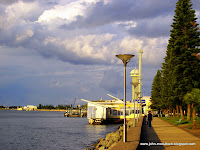The Weston Post Office has a rather unique claim to fame, it was one of the last of three Post Office's to be constructed by the NSW Government in 1916, the others were at Warren and Delungra. It is also interesting to note that while the Australian Postmaster-Generals Department was established at Federation, full control of the postal powers and operations were not handed over to the Commonwealth till 1917 in NSW.
The quaint Federation Bungalow style was the chosen design for country Post Offices of the period and this is the style that was chosen for Weston. There was no hint of the 'Italianate' beauty that was a hallmark of the James Barnett period, nor neither the 'baroque' elegance of the Walter Vernon's period, by this stage Post Office design had become standardised and functional. The halcyon days of Post Office design faded during the tenure of George McRae, as responsibility and costs were slowly transferred to the Commonwealth.
The history of Weston and many other Lower Hunter coalfields towns, were founded on what was known as the Greta Coal Measures, a 245 million year old coal seam that runs from the Illawarra escarpment to southern Queensland and uplifts in the Cessnock area. This uplift was extensively mapped by Sir T.W. Edgeworth David in 1886 and proved attractive to the major coal companies, as the Newcastle coal seams had started to peter out by the late 1800's. The Australian Agricultural Company (A.A.C.) decided to begin operations on this seam around the turn of the century and in late 1902 they advised the government that they were about to sink its first shaft at the new Hebburn Colliery.
Weston, developed close to the Hebburn No.1 Colliery, was originally called Geordietown and was one of many Hunter coalfields towns that were built by private companies (such as AAC), with blocks of land sold in massive auctions to potential employees. When people started moving into these coalfield towns, one of their first demands, after a hotel, was the Post Office and Weston was no different in these demands.
Postal services were established relatively quickly, when compared to other rural area's (probably with the urging of the mining companies) and so on the 25th January 1904, Mr William Walters was appointed the postmaster and he ran the Post Office from his premises on the Cnr of Station Rd and Third Ave. The Morse telegraph arrived in August 1904, after the line was strung from Kurri Kurri and by December 1905, the telephone had arrived in town. Weston was proving to be quite a goldmine for postal services, the quantity of mail alone in 1905 was;
 26,988 - mail articles sent, &
26,988 - mail articles sent, &32,768 - mail articles received
In 1906 the Postmaster-General must have been more than happy with Mr Walters as they extended his contract for another 3 years and included mail deliveries (1/2 mile radius) and telegram deliveries (1 mile radius) in the new contract.
It was with this new extended contract that proved to be the last, as business had expanded so much, so quickly, that Mr Walters even had to employ children to do the letter delivery side of the business. In 1910, the Postmaster-General decided to upgrade the Post Office to official status and Mr Walters took his retirement. The Postmaster-General took over the lease of the existing Post Office premises from Mr Walters for £52 per annum ($37,000). However, the public were soon demanding a better Post Office and one located closer to the main town.
After much agonising over the location and delays bought on by the outbreak World War 1, in 1916, Weston finally had its own purpose built Post Office.
This fine building survived in the Australia Post property portfolio for the next 80 years, becoming part of community, living through, economic Depression, various wars and mine closures (Hebburn No.1 closed in 1972). As the population drifted, so did the requirement for a dedicated Post Office and so in 1996, as with many Post Offices around that time, the building was sold off and the operations transferred to LPO status.
Today the Post Office is combined with a video/DVD rental store and is struggling to maintain revenues during the current postal downturn. However their fight to survive is testament to the tenacious attitude of the coalfields people in that they continue to fight for their town, hoping that the coal trains that are now once again rumbling along the nearby train tracks will herald a resurgence in the towns prosperity.
Perhaps the postman will, once again ring twice, for the tiny coalfields town of Weston.
I'd to thank Brian Andrews & the staff from Sir Edgeworth David Memorial Museum at Kurri Kurri for all their assistance in compiling this blog.






















+copy.jpg)
.jpg)



















